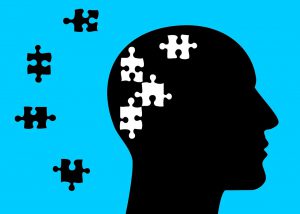We’ve all heard the jokes and seen the memes: adulting is hard. Yes, yes it is: getting yourself to work every day so you can pay your bills, doing taxes, grocery shopping – none of it is exactly fun. Maybe it all makes you long for the days when someone took care of all the important stuff for you, someone who not only helped you with what you needed to do, but kept everything organized, remembered where everything was, and did the worrying for both of you.
So what kind of magical being could possibly do all of that? Well, in many families, that burden falls on the mother of the house, who can often end up feeling burnt out, not just because of all the actual tasks she has to do (and there are a lot of them!), but because of what’s known as the “mental load” (also known as cognitive labor, worry work, or invisible labor) that goes along with having all of those responsibilities. All of this keeping on top of things can lead to mental and even physical issues for (usually) moms, so what can you do to keep yourself from drowning under the weight of the mental load?
What Is the Mental Load?
What runs through your mind as you try to fall asleep at night? If it’s fluffy sheep leaping through a meadow as you peacefully count them, we’re not talking to you – but if it’s things like taking mental inventory of how much toilet paper is left in the house, making a list of appointments to make for your kids, and trying to remember if you defrosted dinner for the next day, then you know exactly what the mental load is.
It’s the behind-the-scenes work of managing a household full of people; it’s the overseeing of everything; it’s being burdened with never-ending to-do lists constantly running through your mind – and it’s making you feel overwhelmed. You help with the homework, keep the kitchen stocked (while remembering what everyone likes, at least for that week), schedule everything (and somehow keep those schedules straight in your head), take those few extra minutes to check all the coupon apps to stay on budget, do the laundry, make any and all travel prep, know everything that’s going on your kids’ lives, and basically keep a running list of everything that needs to be done.
And, more than likely, if you’re nodding along to all of this, you’re a woman and a mother in a heterosexual partnership. For example, here are some eye-opening statistics:
- A 2019 study found that women in heterosexual relationships tend to take on more of the cognitive labor. They found this particularly true when it came to anticipating the needs of others and monitoring progress.
- Another 2019 study found that 65% of the moms who participated had a job, but 88% reported they were still the ones that primarily managed routines at home, and 76% said they were mostly responsible for maintaining regular household standards and order. And, according to a New York Times survey, 66% of women say they’re responsible for child care and 70% say they’re in charge of housework.
- In one study, nearly 9 in 10 partnered mothers said they felt solely responsible for managing their families’ schedules; another study found that 72% of working moms feel that it’s their responsibility to keep on top of their kids’ schedules.
- 52% of working moms say they feel burnt out from staying on top of everything.
- Roughly 3 in 5 working women say they think about household tasks while at work.
- 69% of working moms agree that household responsibilities create a mental load.

And just because division of labor has become more equitable in many households over the past few decades, doesn’t mean that the mental load has gotten any lighter; if anything, women are recognizing it more. In fact, according to Lucia Ciciolla, PhD, a psychologist at Oklahoma State University who has researched the impacts of invisible labor on mothers, “even though women may be physically doing fewer loads of laundry, women are realizing that they continue to hold the responsibility for making sure it gets done – that the detergent doesn’t run out, that all of the dirty clothes make it into the wash, that there are always clean towels available, and that the kids have clean socks. Women are recognizing that they still hold the mental burden of the household even if others share in the physical work, and that mental burden takes a toll.”
Taking Its Toll
So, no, you’re not imagining things. You not only have a huge amount to do, but you also have a huge amount to think about, and it’s dragging you down and burning you out. And when we say “burning you out,” it’s might be having noticeable mental and physical effects, like:
- Anxiety and depression – Being overwhelmed is taking its toll on women: according to the CDC, 1 in 10 women, mothers included, experience symptoms of depression, and women are almost twice as likely as men to be diagnosed with anxiety disorders. Feeling like you’re never able to step away from everything you’re juggling can cause symptoms of these psychological issues, or heighten them in people who are already prone to experiencing them.
- Sleep deprivation – Sure, when you’re a new mom you’re going to be kept up at night by your baby, but for many women, problems sleeping can continue long past the newborn phase; in fact, 74% of moms have experienced symptoms of insomnia. The physical and mental demands of motherhood might end up keeping you up at night – add onto that the “mom guilt” that is might be playing on your mind, and you have a recipe for serious sleep deprivation, which can in turn lead to irritability, a weakened immune system, and feeling disconnected from your family.

- Memory problems – If you’re a mom, you’ve probably made a joke about “mom brain” at some point, maybe after you’ve misplaced your keys for the tenth time, or forgotten that your glasses are on your head…but you know what? It’s actually a real thing, and taking on the mental load of motherhood certainly doesn’t help improve it. The term for it is “postnatal depletion,” defined as a “physical and mental deterioration” that can occur from losing nutrients like iron, zinc, and B12 following childbirth – but because of the stresses of parenthood, this “depletion” can last for years. According to Suzie Welsh, R.N., MSN, “What happens over time is that mothers take on more of the mental work when raising children, thus leading to ‘mommy brain’ and easily turning into a more serious issue of postpartum depletion.” Women who experience this prolonged depleted state can end up with fatigue that sleep doesn’t help relieve, difficulty concentrating, and memory issues.
- Headaches – How often have you said the words, “Mommy has a headache”? Probably three times more often than your male partner, unfortunately. Why are women three times more likely to experience headaches? Hormones, stress levels, anxiety, lack of sleep, and burnout all contribute to frequent headaches: according to Jaclyn Fulop, board licensed physical therapist, “Stress and the mental load of a mother can wreak havoc on the body, releasing chemicals causing the body to react, going into a state of fight or flight. The body cannot distinguish between an actual threat or the stresses of daily life. If this cycle repeats itself, it will affect the central nervous system and the brain causing pain signals in the body, which can ultimately lead to triggers in the body.”
Is There Anything You Can Do?
The mental load takes up space in your head, is a drag on your physical and mental health, and keeps you from doing things just for you – and we don’t just mean stuff you have to do, but stuff you – gasp – want to do. The only real solution is to take on less, but that can be far more easily said than done, especially for moms, who often have trouble asking for help. But remember, saying you need help is NOT admitting defeat, and taking time for yourself or letting go of certain worries is NOT selfish.
So, while there’s no one solution to this problem, there are some things you can consider to help lighten the load:
- Set boundaries – What’s one of the first words your children learned? No! Now that you’re a mom, you might have to relearn that word, as well as learn to recognize and accept your limitations: you can’t take on everything.

- Make time for yourself – As with all of these ideas, this one can also be tough; after all, you don’t want to make carving out “me time” just another source of stress. So, start small, with say 5 or 10 minutes a day during which you take a walk, meditate, read, or just breathe – anything that grounds you. That, plus adding in 20-minute power naps whenever you can, will also help to reduce headaches and feelings of fatigue.
- Make technology your friend – Whenever you can automate something, do it! For example, put things like diapers or toilet paper on subscription, use grocery delivery services (yes, you’ll still have to order your groceries, but at least you’ll have that extra hour when you’d normally be at the store!), and set up automatic bill pay.
- Talk to your partner – Notice we didn’t use the word “delegate” here. Having to delegate tasks is actually part of the mental load; as the artist EMMA explains in a viral comic explaining the mental load, “When a man expects his partner to ask him to do things, he’s viewing her as the manager of household chores. So it’s up to her to know what needs to be done and when. What our partners are really saying, when they ask us to tell them what needs to be done, is that they refuse to take on their share of the mental load.” So how do you approach this? Well, that could be a whole article in itself! But think about this:
-
-
- Start the conversation by finding common ground; for example, you can say something like, “I know you value contributing equally to our relationship, and I think you may not realize I have more responsibilities that go unnoticed.”
- Use “I” statements instead of “you” accusations.
- Offer concrete examples of your mental load, including pointing out that delegating itself is part of the load.
- When dividing up tasks, account for the tasks themselves and the invisible labor, and explain that you want to share the management of tasks, not just the tasks themselves.
- Be careful of “gatekeeping,” or monitoring, criticizing, and worrying about the way another person does the things you normally do; trust your partner to get things done, and if it’s truly important to you that something gets done a certain way, explain why. Remember, you’ve probably internalized a lot of expectations about how your house should be run, so letting go can be hard – but can also be very freeing!

-
- Ask for help in other ways – It’s ok to go outside of your own headspace and let other people in, and we’re not just talking about your partner. Talk with your friends who are moms; they’re probably feeling the same, and would most likely welcome a “me time” exchange, in which one day you let all the kids play at your house while your friend does something she wants to do, and vice versa. And remember, if symptoms of anxiety and depression are creeping in, don’t hesitate to speak to a mental health professional.
Do you recognize yourself in all of this? Trust us, we get it, and we know that the weight of the mental load can be overwhelming, and lead to burn out. That’s why it’s important to carve out time for yourself, as well as reach out to others to let them know that you just need some space to breathe. Being a mom (or a dad!) is a great joy, and also a lot of work, but you don’t need to lose yourself along the way.



